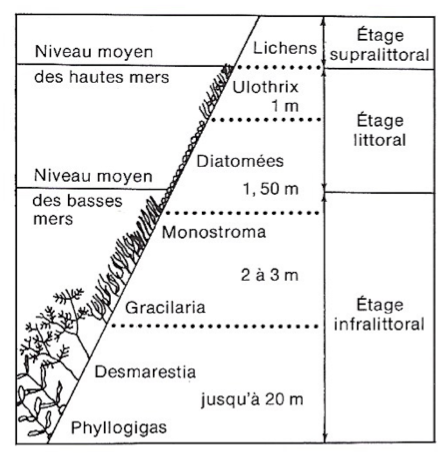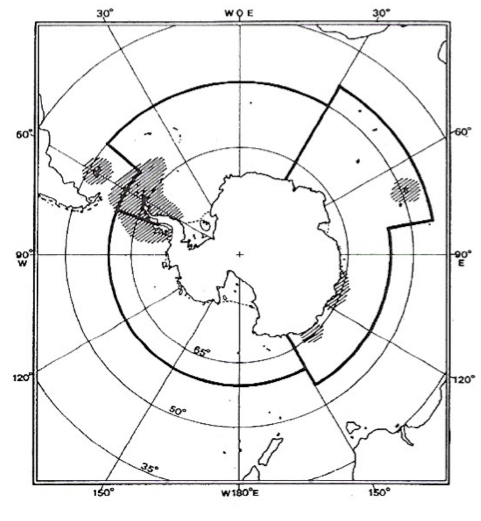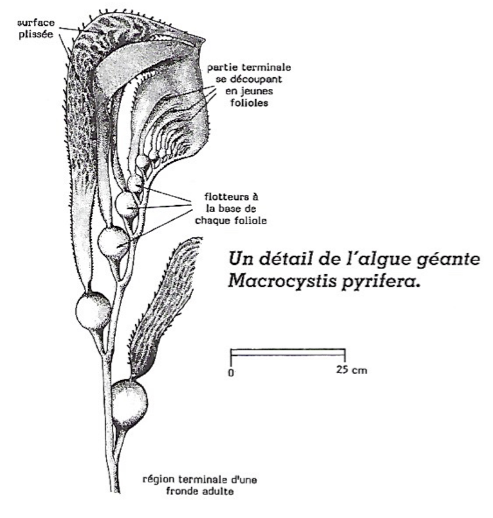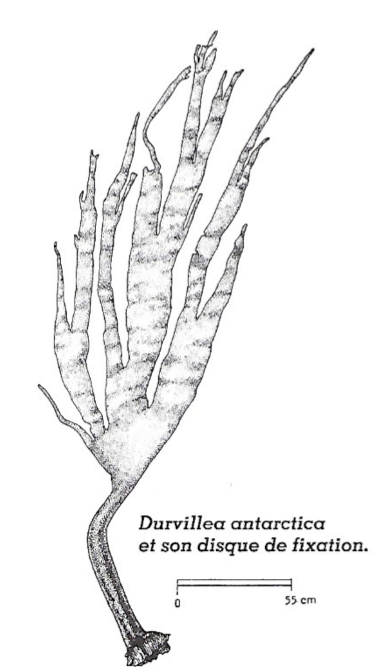Polar Encyclopædia
ALGAE

... giant seaweeds around all the southern and sub-Antarctic coasts with, above all, the immense fields of Macrocystis which will embarrass more than one anchor and, during the descent to land, the slippery interlacing of the rubbery strips of Durvillea. These species do not exist anymore around the Antarctic coasts where others replace them (for example Phyllogigas grandifolius), when the ice does not hinder too much the penetration of light and does not "plow" the bottom too much.

An example of a southern alga distribution: Monostroma harioti.
Large algae visible to the naked eye
The large algae visible to the naked eye, commonly called macroalgae, grow on the shores and on sufficiently lit bottoms. These plants are different, despite appearances, from higher land plants. Indeed, the algae have no roots (but simply spikes or a fixation disc), no branches, no leaves; they are made of a single flexible and resistant material, the thallus, which participates in the vital functions (photosynthesis, growth, reproduction). Hence their name of Thallophytes. This structure allows them to resist the surf.
The algae form a rather heterogeneous group subdivided into green algae (Chlorophyceae), brown algae (Phaeophyceae) and red algae (Rhodophyceae); these colorations depend on the photosynthetic pigments present (chlorophyll, carotenoids). These plants settle on the bottom following a zonation linked to the immersion (limit of high water, tidal swing zone, permanently immersed bottom).
To these macroscopic multi-cellular species, we must add the microscopic algae: archaic "blue-green algae" (Cyanophyceae), Diatoms, Dinoflagellates, etc. Despite their small size, they are more important in terms of capture of (CO2) and biomass than macroalgae.
These unicellular beings are most often planktonic, they drift with the currents even if the dinoflagellates are equipped, as their name indicates, with flagella allowing them to move; some species also develop under the drifting sea ice.

Grow and multiply
All algae need light to perform their photosynthesis from carbon dioxide (CO2) and water, nutrient salts to grow (nitrates, phosphates, sulfates) and oxygen to photorespire (use the oxygen O2 at night). Growth and modes of reproduction are very diversified (fragmentation, cuttings, spores), mixing sexual and asexual reproduction. In Antarctica, the algae grow rapidly during the austral summer.

Some 700 species of macroscopic algae
Some 700 species of macroscopic algae (enteromorphs and green ulvae, fucales and brown kelp, porphyrias and red coralline algae, among others) have been described in southern waters. The giant algae of the sub-Antarctic regions Macrocystis pyrifera and Durvillea antarctica are the most spectacular and their biomass is estimated to be considerable.
The Durvillea constitute a belt generally discovered at low tide. An adult plant can reach 10 meters long. Their growth is carried out by the end of the strips. In Chile, they are used in human food and for the extraction of industrial thickener (alginates). Macrocystis are the largest algae in the world. Their multiple fronds, supported by floats, can exceed 50 meters. They are anchored up to 40 meters deep by a ball of spikes. They represent a particularly important potential source of alginates.
Like the hedges of our countryside, these underwater "forests" shelter innumerable benthic animals (refuge, spawning ground, food), which, themselves, attract numerous birds.
Support the project with a donation
The Polar POD expedition is one of the stamp of the pioners, a human adventure coupled with a technological challenge, an oceanographic exploration never before carried out which will mark a milestone in the discovery of the oceans.
Thank you for your support !